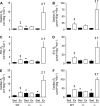Endothelial nitric oxide synthase is central to skeletal muscle metabolic regulation and enzymatic signaling during exercise in vivo
- PMID: 20200137
- PMCID: PMC2867517
- DOI: 10.1152/ajpregu.00004.2010
Endothelial nitric oxide synthase is central to skeletal muscle metabolic regulation and enzymatic signaling during exercise in vivo
Abstract
Endothelial nitric oxide synthase (eNOS) is associated with a number of physiological functions involved in the regulation of metabolism; however, the functional role of eNOS is poorly understood. We tested the hypothesis that eNOS is critical to muscle cell signaling and fuel usage during exercise in vivo, using 16-wk-old catheterized (carotid artery and jugular vein) C57BL/6J mice with wild-type (WT), partial (+/-), or no expression (-/-) of eNOS. Quantitative reductions in eNOS expression ( approximately 40%) elicited many of the phenotypic effects observed in enos(-/-) mice under fasted, sedentary conditions, with expression of oxidative phosphorylation complexes I to V and ATP levels being decreased, and total NOS activity and Ca(2+)/CaM kinase II Thr(286) phosphorylation being increased in skeletal muscle. Despite these alterations, exercise tolerance was markedly impaired in enos(-/-) mice during an acute 30-min bout of exercise. An eNOS-dependent effect was observed with regard to AMP-activated protein kinase signaling and muscle perfusion. Muscle glucose and long-chain fatty acid uptake, and hepatic and skeletal muscle glycogenolysis during the exercise bout was markedly accelerated in enos(-/-) mice compared with enos(+/-) and WT mice. Correspondingly, enos(-/-) mice exhibited hypoglycemia during exercise. Thus, the ablation of eNOS alters a number of physiological processes that result in impaired exercise capacity in vivo. The finding that a partial reduction in eNOS expression is sufficient to induce many of the changes associated with ablation of eNOS has implications for chronic metabolic diseases, such as obesity and insulin resistance, which are associated with reduced eNOS expression.
Figures






Similar articles
-
NOS isoform-specific regulation of basal but not exercise-induced mitochondrial biogenesis in mouse skeletal muscle.J Physiol. 2007 Nov 15;585(Pt 1):253-62. doi: 10.1113/jphysiol.2007.141309. Epub 2007 Oct 4. J Physiol. 2007. PMID: 17916611 Free PMC article.
-
Skeletal muscle AMP-activated protein kinase is essential for the metabolic response to exercise in vivo.J Biol Chem. 2009 Sep 4;284(36):23925-34. doi: 10.1074/jbc.M109.021048. Epub 2009 Jun 12. J Biol Chem. 2009. PMID: 19525228 Free PMC article.
-
Voluntary physical activity alterations in endothelial nitric oxide synthase knockout mice.Am J Physiol Heart Circ Physiol. 2004 Aug;287(2):H914-20. doi: 10.1152/ajpheart.00651.2003. Am J Physiol Heart Circ Physiol. 2004. PMID: 15277206
-
Regulatory role for the arginine-nitric oxide pathway in metabolism of energy substrates.J Nutr Biochem. 2006 Sep;17(9):571-88. doi: 10.1016/j.jnutbio.2005.12.001. Epub 2006 Jan 9. J Nutr Biochem. 2006. PMID: 16524713 Review.
-
Invited review: intracellular signaling in contracting skeletal muscle.J Appl Physiol (1985). 2002 Jul;93(1):369-83. doi: 10.1152/japplphysiol.00167.2002. J Appl Physiol (1985). 2002. PMID: 12070227 Review.
Cited by
-
Exercise-stimulated glucose uptake - regulation and implications for glycaemic control.Nat Rev Endocrinol. 2017 Mar;13(3):133-148. doi: 10.1038/nrendo.2016.162. Epub 2016 Oct 14. Nat Rev Endocrinol. 2017. PMID: 27739515 Review.
-
Nitric oxide regulates vascular adaptive mitochondrial dynamics.Am J Physiol Heart Circ Physiol. 2013 Jun 15;304(12):H1624-33. doi: 10.1152/ajpheart.00987.2012. Epub 2013 Apr 12. Am J Physiol Heart Circ Physiol. 2013. PMID: 23585138 Free PMC article.
-
Glucose-6-phosphate dehydrogenase contributes to the regulation of glucose uptake in skeletal muscle.Mol Metab. 2016 Sep 9;5(11):1083-1091. doi: 10.1016/j.molmet.2016.09.002. eCollection 2016 Nov. Mol Metab. 2016. PMID: 27818934 Free PMC article.
-
The Emerging Role of Hepatocellular eNOS in Non-alcoholic Fatty Liver Disease Development.Front Physiol. 2020 Jul 3;11:767. doi: 10.3389/fphys.2020.00767. eCollection 2020. Front Physiol. 2020. PMID: 32719616 Free PMC article. Review.
-
Nitric oxide, interorganelle communication, and energy flow: a novel route to slow aging.Front Cell Dev Biol. 2015 Feb 6;3:6. doi: 10.3389/fcell.2015.00006. eCollection 2015. Front Cell Dev Biol. 2015. PMID: 25705617 Free PMC article. Review.
References
-
- Ally A, Park G. Rapid determination of creatine, phosphocreatine, purine bases and nucleotides (ATP, ADP, AMP, GTP, GDP) in heart biopsies by gradient ion-pair reversed-phase liquid chromatography. J Chromatogr 575: 19–27, 1992 - PubMed
-
- Ayala JE, Bracy DP, Julien BM, Rottman JN, Fueger PT, Wasserman DH. Chronic treatment with sildenafil improves energy balance and insulin action in high fat-fed conscious mice. Diabetes 56: 1025–1033, 2007 - PubMed
-
- Ayala JE, Bracy DP, McGuinness OP, Wasserman DH. Considerations in the design of hyperinsulinemic-euglycemic clamps in the conscious mouse. Diabetes 55: 390–397, 2006 - PubMed
-
- Balligand JL, Feron O, Dessy C. eNOS activation by physical forces: from short-term regulation of contraction to chronic remodeling of cardiovascular tissues. Physiol Rev 89: 481–534, 2009 - PubMed
-
- Bradley SJ, Kingwell BA, McConell GK. Nitric oxide synthase inhibition reduces leg glucose uptake but not blood flow during dynamic exercise in humans. Diabetes 48: 1815–1821, 1999 - PubMed
Publication types
MeSH terms
Substances
Grants and funding
LinkOut - more resources
Full Text Sources
Miscellaneous

